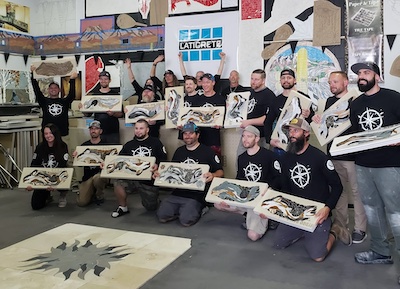
The Artisans Revolution in Tile Premier Tile Artisans Training that took place In June at the Dragonfly Tile & Stone Works shop in Milwaukee was a marvel on many levels (https://tinyurl.com/ARTTraining1 and https://tinyurl.com/ARTTraining2). The magnitude of information shared and technical skills developed were monumental, matched only by the inspiration ignited in everyone who was part of the program.
But technical skills were not the only thing this training encompassed. Dragonfly Tile & Stone Works’ Lee and Jane Callewaert, and Tierra Tile’s Joshua Nordstrom – all NTCA members – addressed marketing custom tile work, building your reputation and portfolio, and exploring opportunities to have your work seen. Lee and Joshua were the instructors at the event.


Working with clients
Lee recommended working directly with the homeowner or designer to discuss custom work. “Sometimes it’s evident that people are into artwork and are collectors,” he said. “Don’t be afraid to say something – you might get shot down at first. And absorb information – colors, artwork, everything around – how they live, what they like,” he added. Have an idea of what art will LOOK LIKE in a space; then think it through before suggesting.
“Do things for what they can be, not what they are,” he encouraged. “You can take the tiniest details and turn them into something fabulous.”
He explained how his “Emily Jane” project developed from a bathroom renovation to an art deco custom shower. The client originally wanted a silhouette of a man on one side of the shower enclosure and a woman on the other. Lee pondered the design and experimented with styles and shapes. He returned for more discussion and the following day produced a full-scale sketch. “They loved it, he said. “It turned into a $30,000 job for the artwork – plus the shower, which also incorporated a high level of detail and precision.”
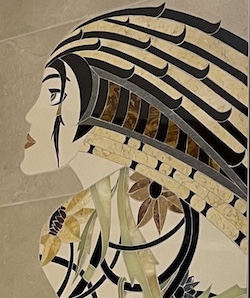

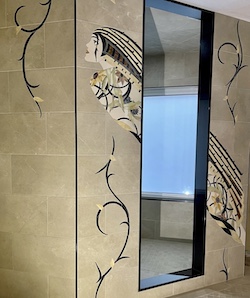

“When you do something like that, you look at everything with a different eye,” Jane said. “You don’t do art, and then do a run-of-the-mill shower.”
Lee employs a “five reason rule” for why art work would work in a customer setting. “Often by the second reason, they are sold,” he said. “Take a very soft approach – don’t over sell or give off an overly-friendly ‘trying-to-sell’ vibe.”
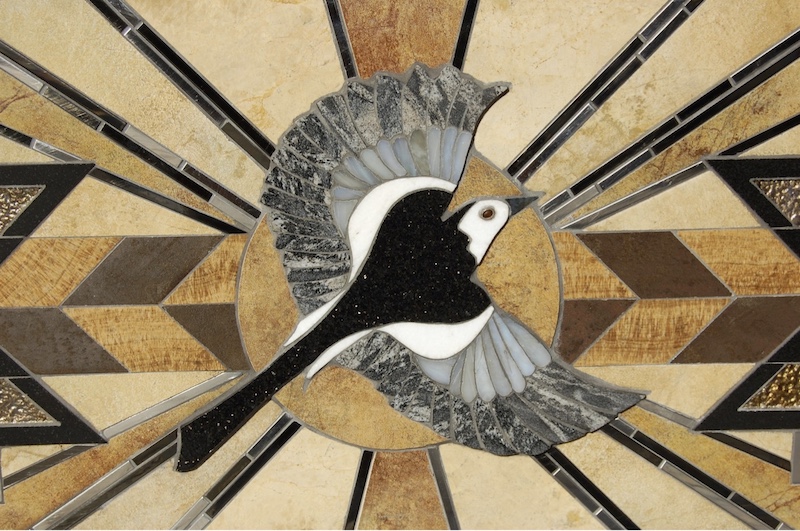

Another example of being attuned to a client was a Latvian woman who wanted birds in her design. Lee developed a design with the national bird of Latvia and integrated some details from hand-carved Latvian clocks. His client loved it. His advice: “Be observant. Pay attention. Do your research.”
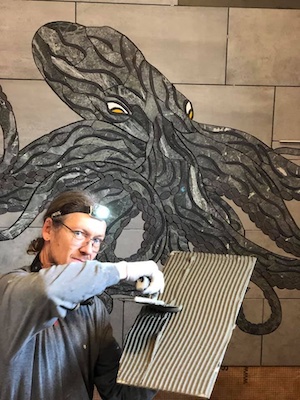

Develop design inspirations from the local geography, Lee and Joshua said. In Lee’s area, many people have lake homes and cabins, so a mosaic of the lake and a marker of where their cabin is, with a gem or birthstone, is an easy sell.
Joshua said the compass rose design is one of the easiest things to sell in his region, due to the prevalence of pilots and people on the water. “There are a lot of straight lines, but you can jazz it up a little with regional preferences like landscapes and symbols. Then over time, people will come to YOU with ideas.”
Joshua has also gotten clients engaged in the design process by giving them a black and white version of the proposed design and asking them to color it.
Building your reputation
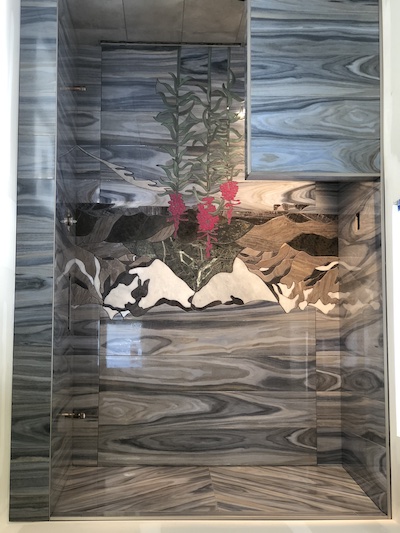

Joshua acknowledged that building a portfolio – and a reputation that leads to word-of-mouth referrals – takes time. It’s not a get-rich-quick endeavor. He suggested some ways to spread the word about your work:
- Make art for a local tile distributor, GC or builder
- Advertise on your vehicle
- Post on social media
- Target Google ads for your region
- Participate in 1% for the Arts projects for public buildings
- Do an artisan school program for kids in grades K-6
- Create paper mosaics for kindergarteners to experiment with
- Give tile art away as gifts
“People can’t buy your work if they don’t know about you,” Joshua said. “After participating in the artisan school program, half the town knew about me and my work.”
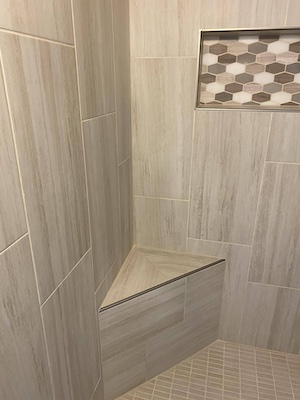

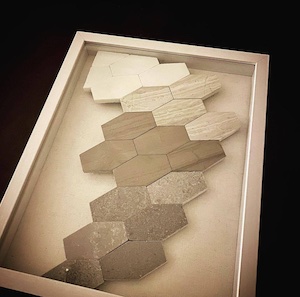

Aryk Snowberger, owner of Snowbee Custom Tile, and one of the artisans at the training, said one of the things he does is to make art – such as a wall hanging – from leftover job scraps for the homeowner. “It helps build a portfolio, and keeps you on their mind. It’s a good faith gesture.”
Though personalizing art is a great idea, it’s best to avoid artwork that is TOO personal, Joshua said. “If they have 50 pictures of Grandma Betty, don’t pitch a mosaic of Grandma Betty – do something more universal since they will sell the house one day.” He added, “Sometimes simple sells. Homeowners don’t always grasp what you can see as an artist. Give a few options and price points. They may like elements from options A, or C.”
Pricing
Pricing is always a challenge due to differing levels of complexity within a project. “Offer price options,” Joshua said. “Try not to scare them away with so high a number that you don’t get the job. You’ve got to know what people are willing to spend.
“And decide on color choices,” Joshua said. “You can do a lot with three to four colors.”
Lee recommends asking for a budget. Don’t forget to include a tool charge that covers parts cost and maintenance. And looking at time cards gives an idea of how much time is invested.
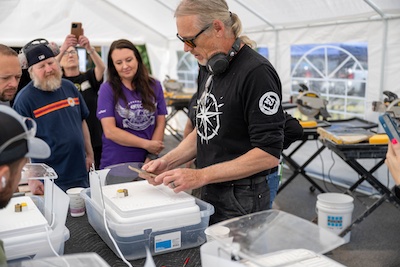

Joshua admitted that he tends to overdesign – and lose money on jobs, even regular installs. “The more lines you draw, the more complex it will be. You can’t price by square footage.” But he offered a formula to give a ballpark idea of what to charge: multiply the number of pieces of tile in the design by a dollar amount – say $20 a piece. So, a 250-piece design x $20 is $5,000. (Don’t share the per-piece pricing with the customer, he warned). Then estimate how much time that may take you to complete; Joshua keeps track of time worked by writing his hours on a piece of blue tape next to him on the job.
Ron Nash, president and CEO of LATICRETE International, a major sponsor of the program along with NTCA, chimed in about ways an art piece can be priced:
- Provenance and history
- Reputation of the artist
- Rarity and demand
- Size
- Previous sales
- Quality and subject
Nash urged tile artists to “learn how to sell” since “sales let you eat.” He emphasizes the importance of “story” to emotionally connect with the client and create a sense of “want.” He pointed to the allure of a Louis Vuitton purse and how the price of the purse includes a “need to be recognized” on the part of the buyer.
Jane Callewaert seconded Nash’s assertion, stating “stories sell!”
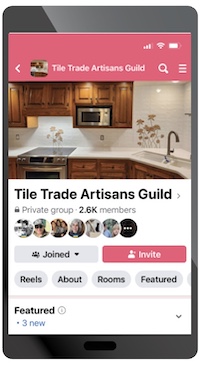

An evaluation process is underway to assess the impact of the program and plan for future opportunities. Installers interested in elevating their craft with custom art features and artisan techniques are encouraged to join the Tile Trade Artists Guild on Facebook, where announcement will be made about future events and support is always available from current artisan tile setters and instructors.
Editorial Director and Senior Writer for TileLetter and TileLetter ARTISAN
Lesley Goddin has been writing and journaling since her first diary at age 11. Her journey has taken her through a career in publishing and publicity, landing her the editor position of TileLetter and its special publications in 2006. Her goal is to educate, inspire, recognize and encourage those in the tile industry -- especially the tile and stone contractor.








